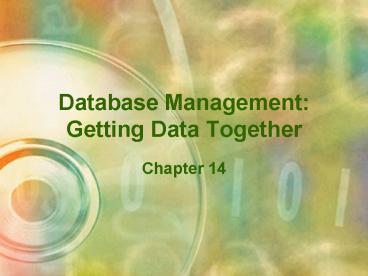Database Management: Getting Data Together - PowerPoint PPT Presentation
1 / 31
Title:
Database Management: Getting Data Together
Description:
Explain the differences between files and databases. List the four database models ... Data can be accidentally damaged or destroyed. Hardware can fail ... – PowerPoint PPT presentation
Number of Views:19
Avg rating:3.0/5.0
Title: Database Management: Getting Data Together
1
Database Management Getting Data Together
- Chapter 14
2
Objectives
- Describe the hierarchy of data
- Explain the differences between files and
databases - List the four database models
- Describe the concept of data integrity
- Describe the functions of a database management
system - Describe the process of creating a database in
general terms - Compare and contrast relational and
object-oriented databases - Explain what a data warehouse is an how it
differs from a database
3
Contents
- Computer Databases
- Database Management Systems
- The DBMS Process
- Concurrency Control
- Security
- Backup and Recovery
- Looking at the Data
4
Computer Databases
- Track information
- Keep consistent standards
- Allow higher productivity as a result of better
information
5
Hierarchy of Data
- Field
- Smallest meaningful unit of data
- Group of one or more characters that has a
specific meaning - Record
- Set of fields containing all information known
about one entity - Each record contains the same fields in the same
sequence - File
- Collection of related records
6
Hierarchy of Data
7
File Processing
- File processing
- Data redundancy
- Database models reduce redundancy
- Saves storage space
- Saves update effort
- Time
- Accuracy
8
Database Models
- Database Types
- Relational
- Object-oriented
- Hierarchical
- Network
- Each type structures, organizes and uses data
differently
9
RDBMSRelational Database Management System
- Organizes data into related tables (files)
- Table consists of rows and columns
- Tables linked based upon a common field (key)
10
RDBMSKey
- Primary key
- A field whose value uniquely identifies a record
- Foreign key
- Primary key of another table
- Used as link to other table
- May have duplicate values
11
OODBMSObject-Oriented Database Management System
- Manipulates object-oriented databases
- Object represents a real-world entity
- Attributes / properties
- Data about the entity
- Methods / Actions
- Operations that work the data
12
OODBMSObject-Oriented Database Management System
- Compared to RDBMS
- More complex
- Steeper learning curve
- Skilled employees needed who earn high pay
- Combined Object/relational DBMS
- Relational database that incorporates some
complex data types
13
Data Integrity
- Degree to which data is accurate and reliable
- Integrity constraints rules
- Acceptable values for a field
- Primary key values
- Foreign keys
- Integrity constraints must be enforced when data
is entered or data is unreliable
14
DBMSDatabase Management System
- Levels of software
- Sophisticated
- Mainframe
- Expensive tens of thousands of dollars
- Complex
- Planned and managed by computer professionals
- Simple
- PC
- Inexpensive few hundred dollars
- User can set up and use the database
15
DBMSDatabase Management System
- Basic functions
- Create a database
- Enter data
- Modify the data as required
- Retrieve information from the database
16
DBMSCreate a Database
- Data Dictionary / Catalog
- Stored data about the tables and fields within
the database - Per table
- Table name
- Relationships
- Per field
- Field name
- Data type
- Field size
- Validation rules
17
DBMSEnter and Modify Data
- Operations
- Adding new data
- Modifying data
- Deleting data
- Methods
- User interacts directly with DBMS
- Programs written by professional programmers
access the data using special commands built into
the DBMS
18
DBMSData Retrieval
- Extracting the desired data from the database
- Primary forms
- Queries
- Reports
19
Query
- Ask a question about the data
- Present criteria that selects data from the
database - Results in smaller portion of the database
- Query Language
- Prepare your query using English-like statements
- Proprietary query language in DBMS
20
Query
- SQLStructured Query Language
- Entered directly by user
- Included in programs
QBE Query-by-Example Graphical interface to
specify your criteria
21
Report
- Formatted presentation of data from the database
- Normally printed
- Designed using a report generator
22
The DBMS Process
Review the data and edit until accurate
Describe the data
Enter the data
23
The DBMS Process
The Plan
The Report
24
Concurrency Control
- Databases are used concurrently by many users
- Problem if several users attempt to update the
same record at the same time - Record locking
- First user requests record
- Others are locked out for update
25
Concurrency Control
26
Security
- Data is stored in a central location
- Problem unauthorized access is major concern
- Benefit easier to apply security measures
- Features
- User ID and password
- Privileges assigned to each user
- Read-only
- Update
27
Backup and Recovery
- Why?
- Data can be accidentally damaged or destroyed
- Hardware can fail
- Forces of nature can cause physical damage
- Software or human errors can corrupt data
- Backup copy made periodically
- Recovery replaces the damaged database with the
good backup
28
Looking at the DataOLTP Online Transaction
Processing
- Supports day-to-day database activities
- Little support for data analysis
29
Looking at the DataData Warehouses
- Databases designed to support ongoing operations
- Data is captured from the db
- Summary form
- Scheduled basis
- Period of time
- May include data from external sources
30
Looking at the DataData Warehouses
- Online Analytical Processing (OLAP)
- Analyzes the data
- Produces information for managers
- Data mining
- Statistical and artificial intelligence
techniques - Look for unrecognized
- Patterns
- Relationships
- Correlations
- Trends
- Helps managers make strategic business decisions
31
(No Transcript)































